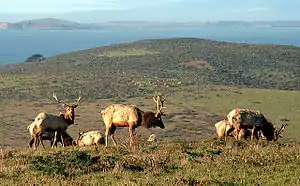Point Reyes National Seashore
Point Reyes National Seashore is a 71,028-acre (287.44 km2) park preserve located on the Point Reyes Peninsula in Marin County, California. As a national seashore, it is maintained by the US National Park Service as an important nature preserve. Some existing agricultural uses are allowed to continue within the park. Clem Miller, a US Congressman from Marin County wrote and introduced the bill for the establishment of Point Reyes National Seashore in 1962 to protect the peninsula from development which was proposed at the time for the slopes above Drake's Bay. All of the park's beaches were listed as the cleanest in the state in 2010.[4]
| Point Reyes National Seashore | |
|---|---|
IUCN category V (protected landscape/seascape) | |
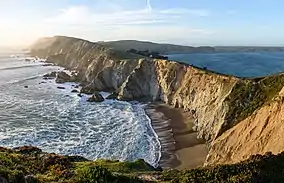 Headlands of the Point Reyes Peninsula from Chimney Rock, looking north. | |
  | |
| Location | Marin County, California, United States |
| Nearest city | Point Reyes Station, California |
| Coordinates | 38°4′N 122°53′W[1] |
| Area | 71,028 acres (287.44 km2)[2] |
| Established | September 13, 1962 |
| Visitors | 2,412,663 (in 2012)[3] |
| Governing body | National Park Service |
| Website | Point Reyes National Seashore |
Geography
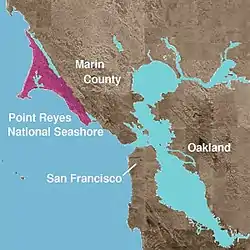
The Point Reyes peninsula is a well defined area, geologically separated from the rest of Marin County and almost all of the continental United States by a rift zone of the San Andreas Fault,[5] about half of which is sunk below sea level and forms Tomales Bay. As the peninsula is on a different tectonic plate than the east shore of Tomales Bay, there is a difference in soils and therefore a noticeable difference in vegetation.
The small town of Point Reyes Station, while not located on the peninsula, provides most services to it. Some services are also available at Inverness on the west shore of Tomales Bay. The small town of Olema, about 3 miles (4.8 km) south of Point Reyes Station, serves as the gateway to the Seashore and its visitor center.
The peninsula includes wild coastal beaches and headlands, estuaries, and uplands. Parts of the park are private farms and ranches which have commercial cattle grazing. These were leased back when the park was purchased to continue these historic uses.[6] Other parts are under the jurisdiction of other conservation authorities with the National Park Service provides signage and manages visitor impact on the entire peninsula and Tomales Bay. The Seashore also administers the parts of the Golden Gate National Recreation area, such as the Olema Valley, that are adjacent to the Seashore.[7]
Wildlife and ecology
Fauna
The northernmost part of the peninsula is maintained as a reserve for tule elk (Cervus canadensis nannodes), an elk subspecies historically native to the region. Elk are readily seen there.[8] Although they had been completely extirpated from Point Reyes by the nineteenth century, in 1978, ten tule elk were reintroduced to Point Reyes from the San Luis National Wildlife Refuge near Los Banos. By 2009, the population climbed to over 440 elk at Tomales Point's 2,600 acres of coastal scrub and grasslands. In 1999, 100 elk from Tomales Point were moved to the Limantour wilderness area of the Seashore and above Drakes Beach to Ranch A, as that ranch's long-term lease expired and was not renewed.[9] The drought in 2012-2015 was also a threat to the elk confined north of the fence on Tomales Point, with nearly half the elk there dying from lack of water. In 2012 there were 540 elk, then only 357 in 2013, and by 2014 only 286.[10] In August and September 2020, drought and wildfires again threaten the Tomales Point elk, leading some conservationists to illegally bring water to the elk north of the fence.[11]
The preserve is also very rich in raptors and shorebirds.[5]
The Point Reyes Lighthouse attracts whale-watchers looking for the gray whale migrating south in mid-January and north in mid-March.
A colony of elephant seals usually congregate on Chimney Beach, which is protected by 100-foot (30 m) cliffs. In January 2019, during the federal government shutdown, park rangers were not working and the seals colonized and had pups on Drakes Beach, and its parking lot.[12][13] Small-group tours to view the seals from the edge of the parking lot began the following month after the shutdown ended.[14]
Flora
Point Reyes lies within the California interior chaparral and woodlands ecoregion.
In his book The Natural History of the Point Reyes Peninsula, Jules Evens identifies several plant communities. One of the most prominent is the Coastal Douglas-fir (Pseudotsuga menziesii) forest, which includes Coast live oak, Tanoak, and California bay and reaches across the southern half of Inverness Ridge toward Bolinas Lagoon. Unlogged parts of this Douglas-fir forest contain trees over 300 years old and up to 6 feet (1.8 m) in diameter. But despite these large, old trees, the forest may nevertheless be a result of European settlement. The Coast Miwok people who once lived in the area set frequent fires to clear brush and increase game animal populations, and early explorers' accounts describe the hills as bare and grassy. But as the Native American settlements were replaced by European ones from the seventeenth century onward, the forests expanded as fire frequency decreased, resulting in the forests we see today.[15]
The Bishop pine (Pinus muricata) forest is found on slopes in the northern half of the park. Many of these trees growing in thick swaths came from seeds released after the 1995 Mt. Vision fire.
Salt, brackish, and freshwater marshlands are found adjacent to Drakes Estero and Abbotts Lagoon. The other communities identified by Evens are the coastal strand, dominated by European beach grass (Ammophila arenaria), ice plant (Carprobrotus edulis, also called sea fig or Hottentot fig), sea rocket (Cakile maritima) and other species that thrive on the immediate coast; northern coastal prairie, found on a narrow strip just inland from the coastal strand that includes some native grasses; coastal rangeland, the area still grazed by the cattle from the peninsula's remaining working ranches;[16] northern coastal scrub, dominated by coyote bush (Baccharis pilularis); and the intertidal and subtidal plant communities.
Point Reyes is home to the only known population of the endangered Sonoma spineflower, Chorizanthe valida.[17]
Climate

| ||||||||||||||||||||||||||||||||||||||||||||||||||||||||||||||||||||||||||||||||||||||||||||||||||||||||||||||||||||||||||||
Landmarks and facilities

The Point Reyes Lifeboat Station is a National Historic Landmark. It is the last remaining example of a rail launched lifeboat station that was common on the Pacific coast.
Nova Albion, Francis Drake's 1579 campsite; Sebastião Rodrigues Soromenho's 1595 wreck; and fifteen associated Native American sites are included in the Drakes Bay Historic and Archaeological District National Historic Landmark. This encompasses 5,965 acres (24.14 km2) along the coast of Drakes Bay.[19]
Kule Loklo, a recreated Coast Miwok village, is a short walk from the visitor center.
Lairds Landing was the site of a wharf on the southwest shore of Tomales Bay.[20] It was named after ranchers, Charles and George Laird, who leased the site in 1858 to transport supplies and produce across the bay.[20] The location was settled by the Felix family around 1861, a family of Filipino and Miwok heritage.[21] After the descendants of the Felix family left in 1955, the land was zoned for development, then made part of the Point Reyes National Seashore, before becoming home to artist Clayton Lewis.[22] In 2015, structures built by the Felix family were placed on the National Register of Historic Places.[23]
More than 30,000 acres (120 km2) of the Point Reyes National Seashore are designated as the Phillip Burton Wilderness, named in honor of California Congressman Phillip Burton, who wrote the legislation creating the Golden Gate National Recreation Area and was instrumental in helping to pass the California Wilderness Act of 1984.
The Point Reyes National Seashore attracts 2.5 million visitors annually. Hostelling International USA (part of Hostelling International) maintains a 45-bed youth hostel at the Seashore.[24]
The Point Reyes National Seashore Association, formed in 1964, collaborates with the Seashore on maintenance, restoration and educational projects.[25]
Hiking

Point Reyes has a system of hiking trails for dayhiking and backpacking. Bear Valley Trail is the most popular hike in the park. It travels mostly streamside through a shaded, fern-laden canyon, breaking out at Divide Meadow before heading downward to the coast, where it emerges at Arch Rock. A portion of Arch Rock collapsed on 21 March 2015, killing one person.[26]

Three trails connecting from the west with the Bear Valley trail head upward toward Mt. Wittenberg, at 1,407 feet (429 m), the highest point in the park.[5] The Earthquake Trail, a 0.6-mile (0.97 km) loop that runs over the San Andreas Fault. The trail provides descriptions of the fault and the surrounding geology, and features a fence that was pulled 18 feet (5.5 m) apart during the 1906 San Francisco earthquake.[27]
At the western end of the Point Reyes Peninsula is the historic Point Reyes Lighthouse, reached by descending 308 steps. Unlike many lighthouses, that were built high so the light could be seen by ships far out to sea, the Point Reyes lighthouse was built low to get the light below the fog that is so prevalent in the area. Nearby is the short Chimney Rock hike, which is noted for its spring wildflower displays.[5]
Point Reyes offers several beach walks. Limantour Spit winds up on a narrow sandy beach, from which Drakes Beach can be glimpsed across Drakes Bay. North Beach and South Beach are often windswept and wave-pounded. Ocean vistas from higher ground can be seen from the Tomales Point Trail and, to the south, from the Palomarin trailhead at the park's southern entrance outside the town of Bolinas.
For backpackers, Point Reyes has four hike-in campgrounds available by reservation.
Point Reyes is a terminus of the American Discovery Trail which is the only transcontinental trail in the United States.[28]
Marine Protected Areas
Point Reyes State Marine Reserve & Point Reyes State Marine Conservation Area, Estero de Limantour State Marine Reserve & Drakes Estero State Marine Conservation Area and Duxbury Reef State Marine Conservation Area adjoin Point Reyes National Seashore. These marine protected areas help conserve ocean wildlife and marine ecosystems.
Management issues
Oyster farm
A large shellfish farm raising Japanese (kumamoto) oysters, Crassostrea gigas, was located in Drakes Estero until, under court order, it closed down at end of 2014. Court appeals to keep the operation in place were dropped in December, 2014.[29]
The farm was purchased by the National Park Service in 1972, and the agency issued a permit to allow the previous owner to continue operations for 40 years. The business was sold to a new owner in 2004, the Drakes Bay Oyster Company, who was informed by the NPS at the time of purchase that their permit to operate would not be renewed beyond the November 30, 2012 expiration date.[30] A federal law enacted in 2009 authorized, but did not require, Interior Secretary Ken Salazar to renew the permit.[31] The NPS and conservation groups viewed the farm as an inappropriate and environmentally-insensitive use of the estero, which was designated a "potential wilderness area" by Congress. The farm's supporters argued that it was not ecologically harmful and was important to the local economy.[31][32]

On November 29, 2012, Salazar announced that he would not renew the permit, citing the original intent of the Point Reyes Wilderness Act to designate the area as wilderness upon the removal of the oyster farm.[30] Salazar visited the farm the previous week and later personally phoned the farm's owner to give him the news.[33]
The oyster farm closure was challenged in U.S. District Court on January 25, 2013.[34] The challenge was rejected by a federal court judge, who ruled that the law gave Salazar unfettered discretion to approve or deny a renewal of the permit.[35] The California Coastal Commission voted on February 7, 2013 to unanimously approve cease and desist and restoration orders for violations of the California Coastal Act.[36] The United States Court of Appeals for the Ninth Circuit rejected an appeal of the district court's decision, ruling on Sept. 3, 2013 that the oyster farm's owner had not shown a likelihood of success on the merits because Salazar had acted within his discretion in denying the permit.[37] An attempt to have the appeals court rehear the case was rejected on January 14, 2014 and a petition to the United States Supreme Court[38] was denied on June 30, 2014.[39] The oyster farm closed its on site retail operation on July 31, 2014.[40][41] However, controversy continued over the condition of the estero sea floor and the ongoing off shore operations.[42] Another lawsuit challenging the closure itself was rejected in September 2014.[43][44]
The work to remove the offshore racks and onshore buildings was completed in May 2017; 1,700 tonnes (1,700 long tons; 1,900 short tons) of debris had been hauled away. The estero is part of the Phillip Burton Wilderness.[45][46]
Gallery
| Wikimedia Commons has media related to Point Reyes National Seashore. |
 Point Reyes Beach from the Lighthouse Visitor Center
Point Reyes Beach from the Lighthouse Visitor Center McClure's Beach
McClure's Beach.jpg.webp) Point Reyes Lighthouse
Point Reyes Lighthouse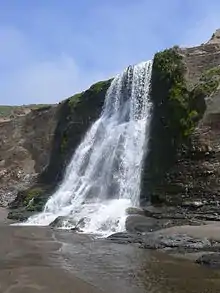
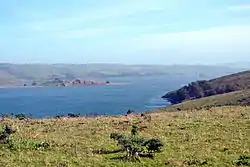 Tomales Bay on the Eastern side
Tomales Bay on the Eastern side Coastline as seen from Chimney Rock
Coastline as seen from Chimney Rock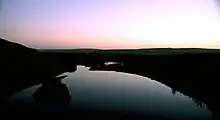 Point Reyes Marsh at dusk
Point Reyes Marsh at dusk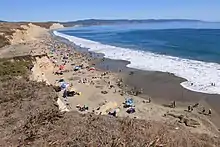 Drakes Beach during the 2015 Annual Sand Sculpture Contest.
Drakes Beach during the 2015 Annual Sand Sculpture Contest. Wildcat Beach
Wildcat Beach
References
- "Point Reyes National Seashore". Geographic Names Information System. United States Geological Survey.
- "Listing of acreage as of December 31, 2010". Land Resource Division, National Park Service. Retrieved 2011-07-13.
- "NPS Annual Recreation Visits Report". National Park Service. Retrieved 2013-05-28.
- Bay Area beaches grade well for safe swimming Archived 2010-06-22 at the Wayback Machine, May 27, 2010 by Carolyn Jones, San Francisco Chronicle
- Point Reyes National Seashore Archived 2006-09-29 at the Wayback Machine, National Park Service, U.S. Department of the Interior
- Sabalow, Ryan (August 8, 2019). "Feds plan to kill elk at Point Reyes to protect ranches. Here's how you can weigh in". Sacramento Bee. Retrieved August 9, 2019.
- Houston, Will (2020-09-19). "Point Reyes releases final plan to preserve ranches, cull tule elk". Marin Independent Journal. Retrieved 2020-09-20.
- Post, Charles (March 19, 2015). "A Brief History of Tule Elk on the Point Reyes Peninsula". Marin Coast Guide. Archived from the original on February 10, 2016.
- "Tule Elk". National Park Service. Retrieved 2011-09-05.
- "Drought Likely Cause of Death for 250 Native Elk At Point Reyes National Seashore". AP Press. April 16, 2015. Retrieved September 2, 2020.
- Deborah Moskowitz. "Drought and Wildfire Threaten Tule Elk at Point Reyes National Seashore". Western Watersheds Project. Retrieved September 2, 2020.
- "Elephant seals take over beach at Point Reyes for the second time this year". Los Angeles Times. Associated Press. May 23, 2019. Retrieved 2019-05-24.
- Amy Graff (January 30, 2019). "Elephant seals took over a Pt. Reyes beach during shutdown. It won't reopen anytime soon". San Francisco Chronicle.
- "Beach taken over by elephant seals to reopen for viewing". San Francisco Chronicle. Associated Press. February 1, 2019.
- Brown, Peter M.; Kaye, Margot W.; Buckley, Dan (1999). "Fire History in Douglas-fir and Coast Redwood Forests at Point Reyes National Seashore, California" (PDF). Northwest Science. 73 (3): 205–216. Archived (PDF) from the original on 2008-05-15.
- Serna, Joseph (July 13, 2017). "Conservationists, National Park Service and Point Reyes ranchers reach settlement on disputed land". LA Times. Archived from the original on 22 July 2017. Retrieved 23 July 2017.
- CNPS Profile: Chorizanthe valida Archived 2012-04-23 at the Wayback Machine
- "NASA Earth Observations Data Set Index". NASA. Retrieved 30 January 2016.
- "National Historic Landmarks Program: National Park Service: Drakes Bay Historic and Archeological District" (PDF). Archived (PDF) from the original on February 22, 2014. Retrieved October 23, 2012.
- Durham, David L. (1998). California's Geographic Names: A Gazetteer of Historic and Modern Names of the State. Clovis, Calif.: Word Dancer Press. p. 650. ISBN 1-884995-14-4.
- Christy Avery (2009). Tomales Bay Environmental History and Historical Resource Study (Report). United States Department of the Interior. Retrieved 26 September 2018.
- Curwen, Thomas (18 April 2016). "Reminders of a bohemian artist's past will soon fade at Laird's Landing". Los Angeles Times. Retrieved 26 September 2018.
- Guth, Anna (20 September 2018). "Restoration underway at Lairds Landing". Point Reyes Light. Retrieved 26 September 2018.
- Archived June 17, 2010, at the Wayback Machine
- "About Point Reyes National Seashore Association". Point Reyes National Seashore Association. Archived from the original on 2015-08-21. Retrieved 2015-08-09.
- "Hiker dies, another injured after cliff collapse in Point Reyes". Bay City News. March 22, 2015. Archived from the original on March 22, 2015 – via San Francisco Chronicle.
- Trail Guide & Suggested Hikes - Point Reyes National Seashore Archived 2008-03-15 at the Wayback Machine. Nps.gov. Retrieved on 2013-07-21.
- "Archived copy". Archived from the original on 2015-08-01. Retrieved 2018-04-26.CS1 maint: archived copy as title (link) American Discovery Trail website retrieved October 21, 2010
- "Legal stand ends for Drakes Bay Oyster Co. supporters". marinij.com. Archived from the original on 7 December 2014. Retrieved 3 May 2018.
- Secretary Salazar Issues Decision on Point Reyes National Seashore Permit Archived 2014-04-17 at the Wayback Machine, United States Department of the Interior, November 29, 2012
- 9th Circuit Mulls Fate of California Oyster Farm Archived 2014-12-08 at the Wayback Machine, Courthouse News Service, May 15, 2013.
- "Oyster farm battle". Retrieved September 9, 2012.
- "Interior secretary denies renewal of oyster company lease on national seashore in California". Archived from the original on December 12, 2012. Retrieved November 29, 2012.
- "Drakes Bay attorneys argue for injunction to keep oyster operation open". Archived from the original on January 27, 2013. Retrieved January 27, 2013.
- "Federal judge declines to halt closure of Drakes Bay Oyster Co". Archived from the original on February 8, 2013. Retrieved February 4, 2013.
- Prado, Mark (February 8, 2013). "Point Reyes oyster farm dealt another setback". Marin Independent Journal. Archived from the original on 30 May 2013. Retrieved 22 July 2013.
- Appeals court deals blow to Drakes Bay Oyster Co. Archived 2013-09-04 at the Wayback Machine, Bob Egelko, San Francisco Chronicle, Sept. 3, 2013
- "Court denies Drakes Bay Oyster Co. petition to have its case reheard". Archived from the original on January 16, 2014. Retrieved January 14, 2014.
- "U.S. Supreme Court refuses to take Drakes Bay Case". Archived from the original on July 6, 2014. Retrieved June 30, 2014.
- Drakes Bay Oyster Co. to shut down this month per federal order Archived 2014-07-25 at the Wayback Machine, Mark Prado, Marin Independent Journal, July 10, 2014
- Cart, Julie (July 18, 2013). "Oyster farm must comply with California coastal laws, judge rules July 18, 2013". Los Angeles Times. Archived from the original on 29 August 2016. Retrieved 20 August 2016.
- "Trash, Invasive Species Left Behind as Controversial Oyster Farm Closes". kcet.org. 20 August 2014. Archived from the original on 5 September 2015. Retrieved 3 May 2018.
- "Court battle over Drakes Bay oyster farm set to resume". pressdemocrat.com. 6 September 2014. Archived from the original on 22 December 2017. Retrieved 3 May 2018.
- Kovner, Guy. Judge rejects firms’ bid to keep Drakes Bay Oyster Co. open Archived 2014-09-11 at the Wayback Machine, Santa Rosa Press-Democrat, 9 September 2014
- "Point Reyes estuary gets cleanup after 80 years of oyster farming". Santa Rosa Press Democrat. 13 April 2017. Archived from the original on 6 January 2018. Retrieved 3 May 2018.
- "Drakes Estero Restoration - Point Reyes National Seashore (U.S. National Park Service)". www.nps.gov. Archived from the original on 17 March 2018. Retrieved 3 May 2018.
External links
| Wikimedia Commons has media related to Point Reyes National Seashore. |
- National Park Service official website about Point Reyes
 Point Reyes National Seashore travel guide from Wikivoyage
Point Reyes National Seashore travel guide from Wikivoyage- West Marin Chamber of Commerce site about Point Reyes
- Point Reyes National Seashore Association, a nonprofit organization working in coordination with the National Park Service.
- Kule Loklo, a recreation of a Coast Miwok Indian village
- Video on controversy over lack of water for tule elk at Tomales Point
